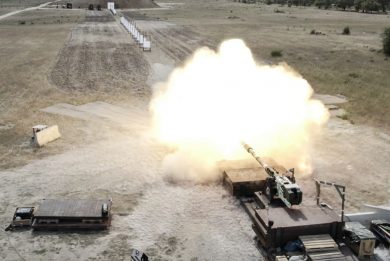Eurosatory 2024 – Mine warfare looms large as peer warfare returns to the cards
Area denial weapons and mine warfare loomed large at this year’s Eurosatory event in Paris with new systems on display from remotely-operated anti-tank mines to scatterable systems deployed by remote combat vehicles (RCV) and proven off-route mines
The prospect of peer warfare requiring area-denial or counter mobility weapons has returned to the cards for most militaries and is driving development within the defence industry. All of the systems presented include multi-sensor fuzes representing a clear departure from pressure only mines as well as remote fuzing technology allowing the mines to be activated or deactivated as required.
KNDS and Dynamit Nobel displayed the Skorpion 2 counter mobility system, which paired the Skorpion 2 scatterable anti-tank mine system with the Type X (RCV) from Milrem, and the AT2+ mine from Dynamit Nobel. The Skorpion has the capacity to deploy 400 mines in ten minutes, which is sufficient for a mine belt with a width of 2,000 metres. The density of mines is not clear and KNDS notes that it would “disturb” enemy forces and allow obstacles of a set shape to be constructed.
The mine scattering system as fitted to the Type X has a gross weight of 3.4 tonnes and 1.9 tonnes unloaded. It consists of four rotating scattering units, each of which is loaded with five magazines of 20 AT2+ mines. The AT2+ builds upon the original AT2 mine, which has been delivered to Ukraine and can be deployed by rocket launcher as well as the Skoprion 2’s predecessor. The AT2+ includes a multi-sensor capability, however, it is not clear exactly what is meant by this as the original AT2 carried the S3 scratch wire contact fuze that would trigger detonation upon scratching the bottom of a vehicle, as well as a magnetic fuze and a detonation upon crushing function. It is armed with a shaped charge that is optimised for behind armour effects and can penetrate 140 mm of rolled homogeneous armour, according to Dynamit Nobel.
The system comes complete with a command and control unit that enables the position of the mines to be automatically recorded and entered into battle management systems for later demining, or to ensure that friendly troops do not enter the mine belt. The standard self-destruct fuze is fitted and it can be programmed by the user before deployment.
Scatterable mine laying systems are particularly useful for large defensive positions occupied by relatively few troops. Good placement should ensure that an enemy chooses a different route altogether – one that is covered by fires – or becomes immobilised in the minefield where further losses can be inflicted. However, the scattering of mines can be unpredictable and the density is hard to control. Ideally they should be combined with other mine types that are laid manually to increase the likelihood of an adversary vehicle triggering a mine.
Finland’s Forcit Defence presented its new Sentry anti-tank mining system during Eurosatory which has been designed to provide area denial against heavily armoured vehicles; it consists of a 10.5 kg mine with encrypted mesh connectivity to enable remote operation. It includes a communication link with a rugged control unit that ensures that the location of the mine is marked with GPS and any movement or changes to its position are recorded and the operator alerted. The mine is operated using the control unit and can be remotely disarmed if friendly units need to pass.
It is armed with an explosively formed penetrator that can defeat up to 140 mm of rolled homogeneous armour. Once the mine is armed and triggered by an approaching vehicle, it autonomously times its detonation to ensure maximum penetration. Its sensors also mean that it reacts to the vehicle’s presence, as opposed to the pressure of a track or wheel passing over the mine. This means that, like the AT2+ it may detonate underneath the vehicle. In this format, mines can be positioned at 2.5 metres intervals and in belts 20 metres apart, this means that nine mines would be required to close a standard two-lane road. It would take around 26 conventional pressure activated mines to achieve the same effect, according to Forcit.
Anti-tank mines can play a very important role in defensive combat, especially against large armoured formations. They provide channelling effects into more advantageous terrain for the defender or they can be used to break the momentum of an advance to allow other weapons to come into action and inflict losses on the attacking force. Russian minefields in Ukraine were often laid at very high densities with anti-mank mines stacked two or three mines deep. In many cases, the anti-tank mines would be laid alongside anti-personnel mines to counter efforts to disrupt them. Russian units would also often re-lay minefields using rockets after the Ukrainians had cleared them. These tactics proved effective in degrading Ukrainian offensive operations when combined with large quantities of artillery, anti-tank missiles, and artillery. The same tactics are also effective against Russian offensives, as the Ukrainians have shown, which is indicative of the value that mines provide in a peer warfare.
Photos by S. Cranny-Evans






